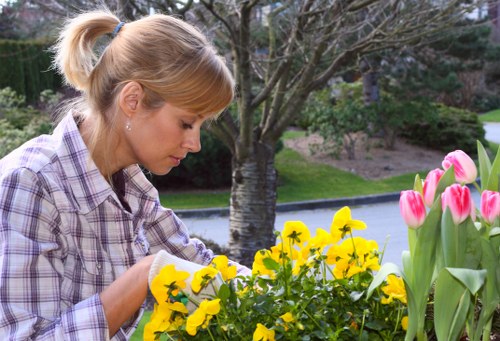Grass Cutting in Lawn Mowing

Maintaining a well-manicured lawn starts with one fundamental task: grass cutting in lawn mowing. Whether you're a homeowner striving for a picturesque yard or a professional landscaper ensuring client satisfaction, understanding the nuances of grass cutting is essential. This comprehensive guide delves into the importance, techniques, and best practices of lawn mowing to help you achieve a lush, healthy lawn.
Grass cutting isn’t just about aesthetics; it plays a crucial role in the overall health of your lawn. Regular mowing helps in promoting dense growth, preventing weeds, and maintaining the desired height for different grass types. By mastering the art of grass cutting, you can transform your outdoor space into a verdant retreat.
In this article, we will explore various aspects of grass cutting in lawn mowing, including the benefits of proper mowing, choosing the right equipment, effective techniques, and common mistakes to avoid. Whether you're a novice or an experienced gardener, this guide offers valuable insights to enhance your lawn care routine.
Importance of Regular Grass Cutting

Regular grass cutting is a cornerstone of effective lawn maintenance. It ensures that your grass remains healthy, vibrant, and free from pests and diseases. Consistent mowing encourages the grass to grow uniformly, creating a dense and resilient lawn that can better withstand environmental stresses.
Maintaining the right grass height through regular cutting helps in optimizing photosynthesis, the process by which plants convert sunlight into energy. When grass is cut too short or too infrequently, it can weaken, making it susceptible to weeds and other adverse conditions. Therefore, establishing a consistent mowing schedule is vital for sustaining a lush and thriving lawn.
Moreover, regular mowing enhances the overall appearance of your property, boosting curb appeal and providing a welcoming environment for outdoor activities. A well-kept lawn serves as a canvas for landscaping elements, complementing gardens, pathways, and outdoor furniture.
Benefits of Proper Lawn Mowing
- Enhanced Grass Health: Proper mowing practices promote stronger grass roots and overall plant health.
- Weed Control: Regular cutting helps prevent weed seeds from germinating and reduces competition for nutrients.
- Improved Aesthetics: A neatly mowed lawn enhances the visual appeal of your property.
- Thatch Prevention: Frequent mowing reduces the buildup of thatch, a layer of dead grass and roots.
- Stress Reduction: Trimming grass removes damaged or diseased blades, minimizing stress on the lawn.
Techniques for Effective Grass Cutting

Implementing the right techniques in grass cutting can significantly impact the health and appearance of your lawn. Adopting best practices ensures that each mow contributes positively to the overall well-being of your grass.
Start with the Right Equipment: Choosing the appropriate mower is the first step towards effective grass cutting. Whether you opt for a push mower, riding mower, or robotic mower, ensure it suits the size and type of your lawn.
Adjust Mower Height: Setting the mower blade to the correct height based on your grass type promotes optimal growth. Different grasses have varying height requirements, so it's essential to familiarize yourself with your specific lawn's needs.
Choosing the Right Mower
- Push Mowers: Ideal for small to medium-sized lawns, push mowers offer simplicity and control.
- Riding Mowers: Suitable for larger areas, riding mowers save time and reduce physical effort.
- Electric Mowers: Eco-friendly options that are quiet and low-maintenance.
- Cordless Mowers: Provide mobility without the constraints of a power cord.
- Robotic Mowers: Automated solutions that mow your lawn with minimal intervention.
Best Practices for Lawn Maintenance

Adhering to best practices in lawn maintenance ensures that your grass cutting efforts yield the best results. These practices not only enhance the health of your lawn but also make the mowing process more efficient and enjoyable.
Establish a Mowing Schedule: Mowing frequency depends on the grass growth rate, which varies with seasons and weather conditions. Typically, lawns require mowing once a week during peak growth periods.
Maintain Mower Blades: Sharpening your mower blades regularly ensures clean cuts, reducing the risk of tearing grass blades and minimizing disease susceptibility.
Mowing Frequency and Height
- Frequency: Generally, mowing every 7-10 days is recommended, but this can vary.
- Height: Aim to cut no more than one-third of the grass blade length in a single mow to prevent stress.
- Seasonal Adjustments: Adjust mowing height based on seasonal growth patterns; for example, lower heights in spring and higher in summer.
- Grass Type Considerations: Different grasses have specific height requirements for optimal health.
Common Mistakes in Lawn Mowing

Even with the best intentions, certain mistakes in lawn mowing can hinder the health and appearance of your grass. Recognizing and avoiding these common errors is crucial for maintaining a pristine lawn.
Cutting Too Short: Mowing grass too short, known as scalping, exposes the roots to the sun and air, leading to weakened grass.
Irregular Mowing Patterns: Changing mowing directions with each session promotes upright growth and prevents soil compaction.
Avoiding Overcutting
- One-Third Rule: Never remove more than one-third of the grass blade in a single mow to maintain plant health.
- Adjust Mower Settings: Ensure your mower is set to the appropriate height for your grass type.
- Monitor Grass Growth: Stay attentive to growth rates and adjust mowing frequency accordingly.
- Use Mulching Mowers: These mowers finely chop clippings, returning nutrients to the soil without overcutting.
Sustainable Lawn Care
Embracing sustainable practices in lawn mowing not only benefits your grass but also contributes positively to the environment. Sustainable lawn care focuses on reducing chemical usage, conserving water, and promoting eco-friendly mowing techniques.
Eco-friendly Mowing: Opt for electric or manual mowers to reduce carbon emissions. Avoid gas-powered equipment when possible.
Water Conservation: Mow during cooler parts of the day to minimize water loss and promote efficient watering practices.
Eco-friendly Grass Cutting Methods
- Mulching: Utilizing mulch mowers recycles grass clippings, enriching the soil.
- Solar-powered Mowers: Harnessing solar energy for mowing reduces reliance on non-renewable resources.
- Natural Fertilizers: Use compost and organic fertilizers to maintain soil health without harmful chemicals.
- Integrated Pest Management: Employ natural pest control methods to maintain lawn health sustainably.
- Manual Tools: Traditional push mowers and trimmers offer sustainable alternatives to motorized equipment.
By integrating these sustainable practices into your lawn care routine, you can achieve a beautiful and environmentally responsible lawn.
Conclusion
Grass cutting in lawn mowing is a fundamental aspect of lawn maintenance that directly impacts the health, appearance, and sustainability of your outdoor space. By understanding the importance of regular mowing, employing effective techniques, and adhering to best practices, you can cultivate a lush, vibrant lawn that enhances your property's beauty and value.
Remember to choose the right equipment, maintain proper mowing heights, and avoid common mistakes to ensure your lawn remains in optimal condition year-round. Additionally, embracing sustainable lawn care practices not only benefits your grass but also contributes to a healthier environment.
Ready to transform your lawn? Contact us today to book your grass cutting service and experience the difference a well-maintained lawn can make!